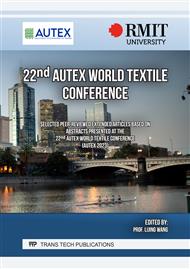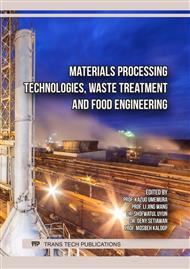p.87
p.97
p.107
p.119
p.125
p.137
p.143
p.149
p.155
In Situ Measurement of Twist Propagation and Yarn Tension with Superconducting Magnetic Bearing Twisting Element for Ring Spinning Process
Abstract:
The twisting of yarn in one of the most widely used conventional ring spinning processes is based on the ring/traveler system. The existing limitation of productivity in the ring spinning process lies on the prevailing force relation between ring, traveler and yarn as well as the frictional heat between traveler and ring, principally in the ring traveler system. Recently, a frictional free twisting element based on a superconducting magnetic bearing (SMB) was developed to increase the productivity of ring spinning drastically, which was patented by ITM and Leibniz IFW Dresden. This SMB consists of a circular superconductor and a permanent magnet (PM) ring. In the superconducting state, the PM ring levitates and can freely rotate even up to an angular speed of 50.000 rpm. It is connected with the spindle via the yarn through a guide attached to the PM ring to impart yarn twist. Through the rotation of the PM ring, the twist propagates to the nip point of the delivery rollers. The twist propagation rate depends on different parameters, e.g., spindle speed, balloon geometry, and friction between yarn and yarn guides. A change in the level of twist affects the process, yarn tension, yarn breakage rate, and yarn properties. Hence, it is important to investigate the twist distribution to derive effective measures for improving the twist propagation especially at higher angular spindle speeds and thus eliminate weak points to increase process stability and yarn quality. The aim of these measurements is to analyze the twist distribution along the yarn path to understand the causes of yarn breakages. In this study, the yarn path was traced at different regions by in-situ measuring the helix angle of twisted yarn using a high-speed camera. From the recorded images, the number of twists per unit length was determined using the image processing software ‘Image J’. Thus, the measurement method allows a new insight into the problem of yarn breakages originating from twist propagation in order to take optimized measures at higher angular spindle speeds.
Info:
Periodical:
Pages:
155-162
Citation:
Online since:
March 2024
Price:
Сopyright:
© 2024 Trans Tech Publications Ltd. All Rights Reserved
Share:
Citation:



